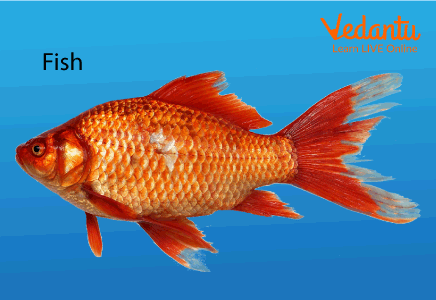




Information of Fish
What Do You Already Know About Fish?
Fish is an aquatic animal. Instead of limbs, they have "fins" that allow them to swim and stream through the water. Fish may be found in abundance in most aquatic bodies. Fish are a vital resource for humans all around the world since they may be found in almost all aquatic settings. Fish are water-dwelling vertebrate creatures. Vertebrate refers to an animal with a spinal cord encased in bone or cartilage.
Fish have gills that draw oxygen out of the surrounding water. The number of fish species is about 30000. Fish have smaller brains than most other animals relative to their body size.

Fish
Characteristics of Fish
Fishes are aquatic creatures.
They are usually found in water which may be freshwater or saltwater but not all organisms living in water are fish.
They have something termed "fins" in place of limbs, which help them in swimming. Most fishes have a tail fin and two other pairs of fins.
They are mostly cold-blooded animals which means that their internal temperature changes with any change in the external environment.
Some of the fishes are also warm-blooded, but they usually show regional endothermy, that is, they can act as endotherms (regulate their internal temperature irrespective of the surroundings) only in certain regions or conditions.
Most aquatic bodies have a large number of fish.
Fishes have gills that help them in breathing underwater.
They also have swim bladders which prevent them from sinking.
Fish are an essential resource for people worldwide since they serve as a protein-rich food source.
Fish are vertebrae by nature.
Fish can breathe underwater with the help of something known as ‘gills”.
Fun Facts About Fish for Kids
Channel catfish have taste buds all over their body.
Fish have gills that draw oxygen out of the surrounding water.
Fish have smaller brains than most other animals relative to their body size.
To aid in their movement through water, fish are covered in scales that are frequently coated in a film of slime.
By eliminating parasites and dead skin from their scales, cleaner fish aid other fish.
Starfish are not fish, neither are jellyfish.
Sharks are the only fish that have eyelids.
The number of fish species is about 30000.
Some flatfish conceal themselves on the ocean floor by using camouflage.
Tuna have a maximum swimming speed of 70 kph (43 mph).
Despite having the term "fish" in their names, crayfish and jellyfish aren't fish.
Fun Facts About Fish Gills
The fish's amazing tiny organs, known as fish gills, enable them to take in oxygen from the water and utilise it as fuel.
Gills are comparable to human and other animal lungs in terms of basic functionality. Functionally, it appears that different fish species have different ways of pushing water over their radiator-like gills.
For the fish to receive the required amounts of oxygen, the gills themselves must have an extensive surface area.

Fish Gills
Fun Facts About Fins
Fins are present in fish as a replacement for the absence of limbs.
A fish may have many fin kinds.
They might be rigid, soft, or even branches and are all supported by rays or spines made of cartilage or bone.
The number of fins on a fish varies depending on its size, mobility, evolution, and other factors.
There are a total of 5 fin kinds.
Fins in fish help them stream through the water effortlessly thus making them very important.

Fish Fin
Learn by Doing:
Which of the following statements is TRUE or FALSE.
1. Fish are aquatic creatures.
2. Fish breathe underwater with the help of the lungs.
3. Fish consist of fins that help them in streaming through the water.
4. Tuna is the fastest fish.
5. There are 5 fish species.
Solved Question
1. What are fish gills?
Ans: Fish gills are remarkable, microscopic organs that allow fish to breathe oxygen from the water and use it as fuel.
Summary
Water-dwelling vertebrates include fish. The number of fish species is about 30000. Some flatfish conceal themselves on the ocean floor by using camouflage. Fish gills are remarkable, microscopic organs that allow fish to breathe oxygen from the water and use it as fuel. Fins in fish help them stream through the water effortlessly, thus, making them very important. This article taught us about the various characteristics and fun facts about fish.
FAQs on Fish Facts For Kids
1. How do fish breathe underwater?
Fish breathe using special organs called gills, which are located on the sides of their heads. As water passes over the gills, these organs pull out dissolved oxygen from the water. This process is how fish get the oxygen they need to live, much like how humans use lungs to get oxygen from the air.
2. Why do fish have fins instead of legs?
Fish have fins because they are perfectly adapted for living and moving in water. Fins act like small paddles or rudders that help fish to swim forward, steer, and maintain balance. Legs are designed for walking on land and would not be effective for moving through water.
3. What is the importance of scales on a fish?
A fish's scales are very important as they act like a protective suit of armour. They help shield the fish from predators, injuries, and infections. Most scales are also covered in a layer of slime, which helps the fish glide smoothly through the water and provides further protection against germs.
4. Why are fish classified as vertebrates?
Fish are classified as vertebrates because they have a backbone, also known as a spinal column. This internal skeleton provides structure and support to their body. Any animal with a backbone, including humans, birds, and reptiles, is considered a vertebrate.
5. Do all fish live in the same type of water?
No, different fish are adapted to live in different water environments. The two main types are:
- Freshwater fish: These fish, like trout and carp, live in rivers, lakes, and ponds where the water has very low salt content.
- Saltwater fish: These fish, like clownfish and tuna, live in oceans and seas, which have a high salt content.
6. How are fish different from water mammals like dolphins?
While they both live in water, fish and dolphins are very different. Fish are cold-blooded, lay eggs, and use gills to breathe oxygen directly from the water. Dolphins are warm-blooded mammals, give birth to live babies, and must come to the surface to breathe air with their lungs.
7. Do fish sleep?
Yes, fish do rest, but it's not sleep in the human sense. They do not have eyelids to close their eyes. Instead, they enter a resting state to conserve energy, where they become less active and their metabolism slows down. During this time, they might float in place or hide in a safe spot like a rock or coral.









